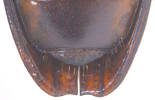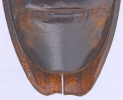 |
Scientific nameBrontispa longissima Gestro (=B. froggatti Sharp, B. castanea Lea, B. simmondsi Maulik, B. Longissima var. javana Weise, B. longissima var.
selebensis Gestro, Oxycephala longipennis Gestro, O. longissima Gestro)
Common nameCoconut hispine beetle, Coconut leaf hispid, New hebrides coconut hispid
Taxonomic positionColeoptera: Chrysomelidae: Cassidinae: Cryptonychini
DiagnosisAdult: Length: 8.5-9.5 mm; width: 2.0-2.5 mm. Body quite flat and narrow, males are slightly smaller than the females. Body color varies from reddish-brown to almost black; sometimes elytra are brown or black, or have a spindle-shaped black marking on the elytral suture. Antennae not serrate, central portion of the head usually parallel-sided, broader than long, rostrum more than half as long as the first antennal segment. Pronotum flattish, shiny, with several large impunctate areas, laterally distinctly concave, anterolateral angles of pronotum expanded, expanded portion broadly rounded,
constricted behind, without a minute projection at inner angle.
Maulik (1938) and Gressitt (1963) have provided keys to separate the adults of Brontispa species, including B. longissima. Egg, larval stages and pupa of B. longissima and related species were described in detail with illustrations by Maulik (1938) and Gressitt (1957, 1963). Similar speciesAmong other coconut hispine beetles, Plesispa reichei is very similar to B. longissima in general appearance. These two species can be distinguished from each other by the
following:
Plesispa reichei is present in Indonesia, Malaysia, the Philippines, Singapore, Thailand, Samoa, and Sri Lanka (CABI). It feeds on the surface of the leaves in nurseries. In the Indian subcontinent, it is present in Sri Lanka and it may spread to India in the near future in view of the geographical proximity and similar climatic conditions in both countries.
ImagesDistributionIndonesia; Irian Jaya; Papua New Guinea; Bismarck Archipelago; Australia; Philippines; Thailand. Myanmar. A potential invasive pest for India.
Hosts / BiologyA serious pest of coconut, arecanut, and ornamental palms. Larvae and adults thrive on the
developing unopened leaves of the coconut palm feeding on the leaf tissues. Severe infestation leads to complete defoliation of the palms. Young palms in poor growing conditions and under prolonged attack die out. In older palms, the productivity is severely affected.
References
|





